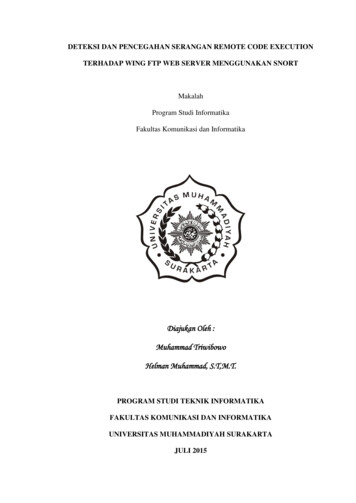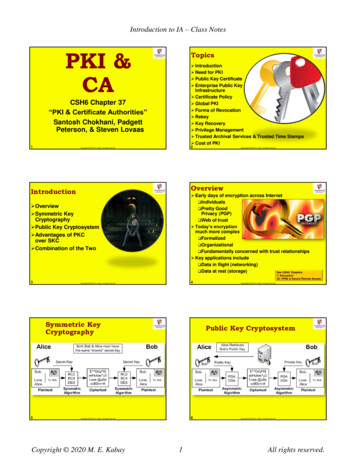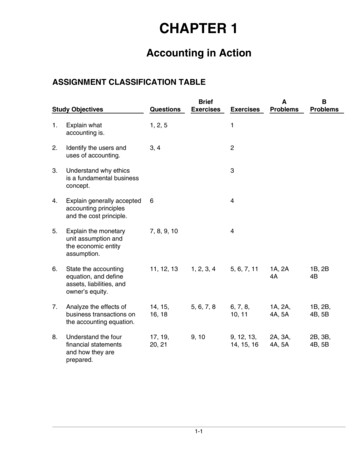
Transcription
Q1. Explain secret and public key cryptography schemes. Use small examples to illustrate your claims. State relativeadvantages of each scheme.Secret Key CryptographyOverviewAlice wants to send a message to Bob. Both Alice and Bob share the same secret key. To encrypt the messageAlice XORs her message with the shared secret key. To decrypt the message Bob also XORs the message with his(the same) secret key.Ex.Key 0011Alice’s message 0101Alice’s message XORed with the key: 0011 XOR 0101 0110What Bob Recieves 0110Bob applies the secret key again to get the original message: 0110 XOR key 0101This works for three reasons: XOR is associative and Any binary value XORed with itself is 0 Any binary value XORed with 0 is itselfThe advantages of secret key cryptography are that1. Performing XOR is very fast.2. It has been well tested.The disadvantages are that1. The key must remain secret.2. Exchanging keys with someone must be done in secret.3. Each communicating pair of people need to share a key.Public Key CryptographyOverviewIn public key cryptography there are two parts to the key: a secret part and a public part. In order for Alice to sendBob a message she first needs to obtain his public key. Because Bob likes to be contacted (albeit only via encryptedmessages) he has published his public key on his homepage for anyone to download. Alice obtains his public key,encrypts a message using this key and then sends it to Bob. Bob is then able to decrypt the message using the secretpart of his own key.Advantages1. Only one part must be kept secret2. There is no need to change your public/private key pair (unless someone finds your public key)3. For N people to communicate there need only be N public/private key pairs.4. There is no need for initial key exchange5. It can serve as a digital signaturea. Alice would like to post a message on a web forum and she would also like everyone reading theforum to be able to authenticate that the message was really posted by her (and not someone elseclaiming to be her). Alice takes her message and uses her private key to encrypt it. If theencrypted message on the forum was really posted by Alice then it should be decryptable using herpublic key. Since everyone has access to her public key this can be verified.Disadvantages
1.2.3.4.Slow do to the enormous amount of computation involved.Keys must be long (at least 1024 bits these days).There is no proof for that any public key scheme is secure.It has not been around long enough to be tested as much.Diffie-Hellman Public Key CryptographyY Public KeyX Secret KeyUser i derives Y in the following way.Yi a (xi) mod gUser j derives Y in the same manner.Yj a (xj) mod gUsers i and j exchange their Y’s and then perform the following computationZij Yj (xi) (a (xj)) (xi) mod g (a (xi)) (xj) mod g ZjiThis value of Z can then be used as the input to a random number generator. These random bits will be used toXOR the original message.Q2. Explain the Diffie-Helman key distribution scheme. Show a small example. Explain (very briefly) other publickey schemes and their relative advantages and limitations.Explain the Diffie-Helman key distribution scheme: Public key cryptography scheme Uses a one-way function. Security due to the difficulty of calculating logarithms as compared to the ease of calculatingexponentiations. Howo Alice and Bob want to generate a secret keyo Public Givens:Large prime number ng primitive mod of nooooooAlice choses a random large number integer x and sends to BobX gx mod nBob choses a random large number y and sends to AliceY gy mod nAlice computesk Yx mod nBob computesk’ Xy mod nThe secret keyk k’ gxy mod nNo one listening can compute the value k since they only know n, g, X, Y, and it is too difficult tocompute the log to obtain x and y.Show a small example:
g 6 35 mod nn 29Alice choses x 101X 6101Bob choses y 53Y 653Alice computesk 653*101Bob computesk’ 6101*53Explain other public key schemes and their relative advantages and limitations: RSA:Difficulty of recovering plain text from cipher test is conjectured to be equivalent to factoring products of largeprime numbersAdvantages:Been around a long time, and heavily studiedDisadvantages:Not proven only conjectured security McEliece:Idea:Based on Algebraic coding theoryConstruct an error-correcting code, specifically a Goppa codeDisguise the Goppa code as a general linear codeFinding a code word of a given weight in a linear binary code is NP complete but fast algorithm exists fordecoding Goppa codeAdvantages:FastDisdvantages:Key is enormousData expansion is large Eliptic Curves:Eliptical curves are utilized to implement algorithms such as Diffie-HellmanAdvantages:Most efficient with regard to key Quadratic residuityQuadratic Residue is based on number theory idea of the same name Largest CliqueAcknowledgement: Applied Crytpography by Bruce Schneier was heavily referencedQ3. Explain the Shamir's secret sharing scheme. Explain its application. Show a small example. Explain potentialalternatives.Objective: Secret Sharing scheme that is both perfect and fault tolerant perfect - stored key does not reveal anyinformation fault tolerant - if one part of key is lost - the key must still be recoverable.Using polynomial interpolation - and the idea that for any polynomial of degree k, for any k-points, there is only oneline that passes through all of these points.
The shares of the key are represented by these points on the k-degree polynomial. By interpolating the line at x 0,the secret is obtained.For example, for a 2-degree polynomial,if the shares are represented by the points x1,y1 , x2,y2 . xn,yn - all of these points lie on the same line. Pick any two points - draw a line throughthem, and the intersection at x 0 is the secret.For a k-degree polynomial, at least k points must be picked to determine the intersection at x 0.The scheme is fault-tolerant because not all shares are needed to determine the secret.In addition the scheme is perfect because the secret can be encrypted. Even complete knowledge of k-1 shares (fork-degree poly) will not reveal the secret.Shortcomings:The scheme does not provide:key revocation if A gives B a share, then decides it wants to take it back,it can not do thistraitor resilience:if A lies to B about the share, then B cannot detect this.References:- Lecture- http://szabo.best.vwh.net/secret.html4. What is perfect secret sharing scheme? Show at least one perfect and three non-perfect schemes.In a secret sharing scheme, the sender divides the secret into n parts and gives each participant one part so that anym parts can be put together to recover the secret, but any m - 1 parts reveal no information about the secret. A secretsharing scheme is perfect if any group of at most m - 1 participants (insiders) has no advantage in guessing the secretover the outsiders.Shamir’s secret sharing scheme is an example of perfect secret sharing. It is an interpolating scheme based onpolynomial interpolation. An (m - 1)-degree polynomial: F(x) a0 a1x . am - 1 xm-1, is constructed suchthat the coefficient a0 is the secret and all other coefficients are random elements in the field. Each of the n shares isa point (xi, yi) on the curve defined by the polynomial, where xi not equal to 0. Given any m shares, the polynomialis uniquely determined and hence the secret a0 can be computed. However, given m - 1 or fewer shares, the secretcan be any element in the field. Therefore, Shamir’s scheme is a perfect secret sharing scheme.Blakley’s secret sharing schemes is an example of non-perfect secret sharing. The secret is a point in an mdimensional space. n shares are constructed with each share defining a hyperplane in this space. By finding theintersection of any m of these planes, the secret (or point of intersection) can be obtained. This scheme is not perfect,as the person with a share of the secret knows that the secret is a point on his hyperplane.Other non-perfect secret sharing schemes are, e.g. secret sharing schemes based on Latin Squares, or Room Squares.5. Explain zero knowledge proof. Demonstrate how zero can be applied to graph coloring and Hamiltonian cycleproblems.A Zero Knowledge Proof is a proof in which a Prover (Peggy) wants to prove to a Verifier (Victor) that she knows aparticular secret. In the process of the proof, however, Peggy doesn’t want to reveal her secret to Victor. In fact,Peggy does not want to reveal even a tiny bit of information about her secret to Victor. In the end, Peggy wantsVictor to have no more information about Peggy’s secret than he could have learned on his own.
Zero Knowledge Proofs usually take the form of a probabilistic, interactive protocol. The protocol is said to beprobabilistic because in the end, Victor will only be certain that Peggy knows the secret with high probability.Usually, the probability that Peggy is gets away with cheating shrinks like (1/2) K where K is the number of roundsin the protocol.Quisquater and Guillou illustrate the concept of Zero Knowledge Proofs with the following example:Peggy and Victor know of a cave that forks into two tunnels. Each tunnel dead-ends at a door. Peggy claims thatthe door connects the two tunnels and that anyone who knows the password can pass through. Victor does notbelieve that Peggy knows the password and asks for proof. Peggy wants to convince Victor that she knows thepassword, but she does not want to reveal what it is. Peggy proposes the following:1.2.3.4.5.Peggy and Victor start at the mouth of the cave. Peggy enters, leaving Victor behind. When she reaches thefork, she randomly chooses one tunnel.Peggy calls to Victor to enter the cave. Victor comes to the fork. Peggy is now committed to the choice shemade. She cannot change which tunnel she is in by walking back to the fork, or Victor will catch her.Victor randomly selects one of the tunnels and calls to Peggy to emerge from that tunnel.If Peggy truly knows the password and can pass by the door, then it is trivial for her to come out the correcttunnel. If she does not, then 50% of the time she will not be able to come out of the right path.Peggy and Victor repeat this protocol many times until Victor is convinced that Peggy is not merely lucky, butthat she can pass from one tunnel to the other through the door and therefore she must know the password.However, Victor knows nothing more about the password than when he started.Now let’s look at the mathematical underpinnings of such a scheme. Let’s suppose that Peggy has a secretexpressed in the form of the solution to a hard problem. Here’s how Peggy can prove that she knows the solution toVictor without giving him any more information than he could come up with on his own.1.2.3.4.Peggy selects a random number and uses it to transform her hard problem into a different hard problem that isequivalent to her initial problem.Peggy then uses a cryptographic commitment scheme to commit to the solution of her new problem instanceand sends that commitment to Victor. If she tries to switch the solution out later, she risks getting caught.Peggy now sends the new problem instance to Victor.Victor randomly chooses to ask Peggy to either:a)demonstrate that the new instance and the old instance are equivalent by providing a mapping between thetwo, orb) demonstrate that the solution she committed to in step 2 is really a solution to the new instance (and showthat it matches the commitment).5.6.Peggy complies as appropriate. Failure to do so will make Victor very suspicious and might be enough toconvince him that Peggy is bluffing.In order to reduce the odds of Peggy being able to get away with cheating, they repeat steps 1--4 until Victor issatisfied that Peggy really knows a solution to the original problem. However, no matter how many times theprotocol is repeated, Victor learns nothing about Peggy’s secret that he could not have learned on his own.Below are schemes for Zero Knowledge Proofs using the Hamiltonian cycle problem and the three-coloringproblem. For those who are a bit rusty on their Graph Theory, the Hamiltonian cycle problem is to find a cycle (ifone exists) that visits every node in a graph exactly once and returns to the starting node. The three-coloringproblem is to find an assignment (if one exists) of color from a set of three colors for each node such that no twoadjacent nodes share the same color.
Zero Knowledge Proof Method for Hamiltonian CyclesSuppose that Peggy has a graph G and that she knows a Hamiltonian cycle for it (probably because she generated Gand in doing so, guaranteed that it had such a cycle). In general, finding a Hamiltonian Cycle in an arbitrary graph isNP-Complete. Peggy has engineered her graph so that it is no exception.Let’s now suppose that Peggy wants to prove to Victor that she knows a Hamiltonian cycle in G, but that she doesnot want to reveal the cycle to Victor. Peggy can prove to Victor that she knows the cycle using the following ZeroKnowledge Proof:1.2.3.Peggy selects a random number and uses it to permute the labeling of G, forming an isomorphic graph H. IfPeggy knows a Hamiltonian cycle in G, she can easily find one in H by applying the labeling permutation.Peggy then encrypts H to get H’ and sends H’ to Victor. (Peggy uses probabilistic encryption on each edge in Hto ensure that Victor cannot attempt to discover H by encrypting various graphs and comparing them to H’.)This commits Peggy to her choice of H.Victor randomly chooses to ask Peggy to either:a) demonstrate that H’ is an encryption of H and that H is isomorphic to G, orb) reveal a Hamiltonian cycle in H by revealing the decryption of the necessary edges in H’.4. Peggy complies by either:a)providing the decryption on H and the permutation of G so that Victor can see that H is isomorphic toG, but without demonstrating a Hamiltonian cycle in G or H, orb) providing the decryption for edges in H’ which form a Hamiltonian cycle, but without demonstratingthat G and H are isomorphic.5.Peggy and Victor repeat steps 1--4 K times. If Peggy ever declines to complete her part of the protocol, orif she ever fails to send valid information in step 4, Victor has reason to suspectPeggy is lying. Otherwise, he is certain with probability 1-(1/2) K that Peggy knows a Hamiltonian cycle in G. Ineither case, he has no more information about G than when he started.Zero Knowledge Proof Method for Graph Coloring:Suppose Peggy knows a three-coloring for a graph G with N nodes and E edges (again, probably because shegenerated G, and in doing so guaranteed it had a three-coloring). In general, finding a three-coloring of a graph isNP-Complete. Suppose again that Peggy has engineered her graph to be no exception.Peggy wants to prove to Victor that she knows a three-coloring of G, but she doesn’t want to reveal this coloring inthe process of the proof. Peggy can prove to Victor that she knows a three-coloring using the following ZeroKnowledge Proof:1.2.3.4.5.Peggy selects a random number and uses is to permute the color labeling of G to produce H. G and H areidentical in all ways except that the colors used for coloring H have been globally permuted from the originalset of colors. This restricts H to one of six possible results of permuting the coloration of G. The resultingthree-coloring must consist of colors from a set, say {C, M, Y}, that Peggy and Victor have agreed upon.Peggy then encrypts H to get H’. (She uses probabilistic encryption on each node to ensure that Victor cannotattempt to discover any colors in H by randomly encrypting various colorings and comparing them to H’.) Thiscommits Peggy to her choice of H.Victor randomly selects two adjacent nodes chooses to asks Peggy to decrypt them, revealing that they arecolored differently (as they must be if the H is correctly three-colored).Peggy checks that the two nodes are indeed adjacent (to make sure Victor isn’t trying to scam her into revealingany information). Then, she provides the decryption for those two nodes, demonstrating that they are indeedcolored differently. Victor is convinced provided that the colors are indeed different, the decryption is correct,and the colors are from the agreed set {C, M, Y}.Again, Peggy and Victor repeat steps 1--4 multiple times. This time, however, computing the odds is not sosimple.
In the Hamiltonian cycle proof, Peggy had a fifty-fifty shot of getting away with lying, since Victor made a 1 in 2random selection. In this proof, Victor must assume that Peggy might be very close to having a three coloring, buthave two nodes adjacent nodes that she must assign the same color. Victor must assume that Peggy may try to slipthis one by him. This makes his odds at detecting her in any given round way worse than 1 in 2.Let’s assume the worst, i.e., that Peggy has a coloring that is wrong for only one pair of nodes. The probability thatVictor will pick the correct two nodes to reveal Peggy as a cheater is 1/E for each round. The probability that Peggygets away with cheating in each round is 1 - 1/E. Thus, the probability that Peggy gets away with cheating in Erounds is (1 - 1/E) E, which conveniently is less than ½ for E 0. Thus, for E * D rounds, the probability of Peggygetting caught is ((1 - 1/E) E) D or (1 - 1/E) (E * D) which, in turn, is less than (1/2) (E * D).So if Victor insists on repeating for (E * D) K rounds, he can be confident with probability at least 1 - (1/2) K thatPeggy hasn’t cheated him.References:Bruce Schneier. Applied Cryptography, Second Edition. John Wiley & Sons, 1996.Oded Goldreich, Silvio Micali, and Avi Wigderson. Proofs that yield nothing but their validity and a method ofcryptographic protocol design. In Proc. 27th IEEE Symposium on Foundations of Computer Science (FOCS), pages174-187. IEEE Computer Society Press, 1986.6. Explain time-stamping protocol.A time stamp logically is an electronic seal including a time indication applied over a document.In practice it's a digital signature over a submitted digest, a time indication and other information.The Time Stamping Protocol defines the entities involved*, the message format and the transport protocol whichpermits the communication between the entities.*The requestor (or client) and the Time Stamp Authority (or server)It's possible to locate two distinct phases:Phase I: request, issue, immediate verify
Phase II: late verify7. Explain how poker can be played over phone. Explain the scheme using both physical analogy mechanisms aswell as by using cryptographical protocols.Suppose the two players are called Alice and Bob. In order to play the poker game, Alice puts her lock on each cardof the deck.Then, she suffles the deck and sends the whole deck to Bob. Bob randomly picks five cards for Alice and sendsthem back to her. Now Alice can unlock her 5 cards and see her hand. Moreover, Bob picks 5 more cards from theremaining cards of the (locked) deck. He also puts his lock on the picked cards and sends them to Alice. Now, Aliceunlocks these cards. Since these cards are also locked by Bob, she can not see Bob’s hand. Then she sends backBob’s hand and Bob can see his hand by unlocking his locks.To express this scheme with cryptographical protocols, the commutative cryptosystems must be used. Suppose thatEa and Da are Alice’s encryption and decryption funstions, respectively. Similarly, Eb and Db are Bob’s. Now ifthese functions are commutative, we have:Ea(Db(x)) Db(Ea(x))Eb(Da(x)) Da(Eb(x))Therefore, the poker game can be played as the following. The deck card is the set {1, 2, ., 52}. Alice encryptseach card separately, and randomly orders the resulting set {Ea(1), Ea(2), ., Ea(52) }. She sends this set to Bob.Bob chooses five cards at random, say {Ea(18), Ea(24), Ea(27), Ea(31), Ea(39)}, and sends them back to Alice.Now Alice knows that her hand is : {18, 24, 27, 31, 39}.Next, Bob chooses 5 different cards form the encrypted deck. Say {Ea(3), Ea(12), Ea(15), Ea(35), Ea(41) } . Heencrypts them and sends the randomly ordered set {Eb(Ea(3)), Eb(Ea(12)), Eb(Ea(15)), Eb(Ea(35)), Eb(Ea(41)) }back to Alice. Noe Alice decrypts each element of the set and sends the resulting set{Eb(3), Eb(12), Eb(15), Eb(35), Eb(41) } back to Bob. Then Bob decrypts the set to get his hand, {3, 12, 15, 35,41}.Once the hand has been played, Alice and Bob exchange their encryption keys and verify that each played fairly.One of the commutative cryptosystems that was initailly proposed for this protocol is the cryptosystem proposed byShamir et al. which is as the following.Alice and Bob agree on a large odd prime number n, and separately choose secret keys k A or k B, where gcd(A,n-1) gcd(b, n-1) 1. Then Ek(x) x k (mod n) and Dk(x) x z (mod n), where kz 1 (mod n-1).Reference:S. Fortune, M. Merritt, “POKER POROTOCOLS”, CRYPTO’84, LNCS 196, pp454-464, 1985.
8. Explain at least four methods for watermarking text. Discuss advantages and limitation. Explain possible attacks.Technique 1:Line Coding Spacing between adjacent lines of text are adjusted up or downto encode data.Technique 2:Word Coding Spacing between adjacent words are adjusted in small amounts.Technique 3:Character Coding Characters are adjusted in small amounts(such as the extending the t in unperceivable amounts)Technique 4:Text Compression Words/Letters are compressed from theaverage according to small amounts to encode data.Technique 5:Natural language watermarking. Embedding data in the wording, sentence structure, or use ofspecific words.Attack Types: Retyping the document or passages from the document OCR to generate digital copy that can then be reprinted Image processing to adjust spacing (ie adding new watermark orin general throwing off existing watermark)Advantages: Techniques 1-4 can be done after the text iswritten in a highly automated fashion. Techniques 1-4 may still be strong afterportions of text are removed (highly redundant) Technique 5 will survive re-typing and OCRbased attacks.Disadvantages: Techniques 1-4 are easy to remove by OCRing the text andreprinting it. Technique 5 may have low redundancy depending on variants All techniques are can be overwritten with a new watermark,although Technique 5 is stronger than the others.
PLEASE NOTE - Techniques 1-3 were taken out ofhttp://www.acm.org/ hlb/publications/dig wtr/dig watr.html,9. Explain at least four methods for watermarking audio. Discuss advantages and limitation. Explain possibleattacks.Explain at least four methods for watermarking audio. Discuss advantages and limitation. Explain possible attacks.1) Put watermark in a frequency that is not perceptible to humans. This is easy to do and can be easily retrieved.However, this can also be easily defeated through filtering and compression.2) A watermark can be inserted in the time domain be speeding up or slowing down the audio. This would be donein small degrees so that humans could not tell the difference. An attacker could use the same method and modifythe time scale. This would destroy the embedded watermark.3) Embed a watermark signal right after a loud signal. The human brain cannot perceive this. This could be easilydetected and erased by an attacker. The attacker could also add noise or do filtering to distort or destroy thewatermark.4) Embed the watermark in the transform domain using FFT(Fast Fourier Transform), DCT(Discrete CosineTransform), or DWT(Discrete Wavelet Transform). An attacker would have to transform the audio and then lookfor the watermark. This could be difficult if the attacker does not know which transform to use or where in the datato look for the watermark.10. Explain at least four methods for watermarking image. Discuss advantages and limitation. Explain possibleattacks.1. One very simple method to watermarking an image is to alter each least significant bit (LSB) in each pixel.Ownership is proved by matching the LSB's of all the pixels to the key originally embedded in the image. Thismethod is good because it does not reduce the quality of the image and it is fast and simple. However, it has norobustness: it is easy to remove the watermark just by removing the bits. It is also not immune to geometricdistortions (scale/crop/rotate), signal processing (dither/recompression/contrast/color), and compression.2. A second way to water mark images is to insert small geometric patterns into the image, creating the patterns byvarying the brightness levels. Ownership is proved by identifying the geometric patters and matching them tothe original patters. This method has a few severe limitations: the amount of information it is possible to encodewith geometric patterns is not very large and this method is sensitive to signal processing and compression.3. Another way to watermark an image is to add or subtract a small random amounts from each pixel. A binary maskof bits is compared with the LSB of each pixel, and if the mask bit and the LSB are equal the small randomamount is added, otherwise the small random amount is subtracted (or vice-versa). Ownership is proved by
computing the difference between the original image and the watermarked image and comparing the sign of theall the resulting pixels to check if they match up with the original sequence of additions and subtractions. Adrawback of this method is that very small amounts must be added and subtracted from each pixel so that thereis no noticeable degradation of image quality. This also makes the the watermark more susceptible to signalprocessing and compression attacks. The watermark is also susceptible to collusion attacks.4. Out of all of these, the best is the spread spectrum/DCT method. This method is performed by first applying afrequency domain transformation to the image; typically this is a discrete cosine transformation (DCT). Next,the perceptually significant regions of the image are determined. A key is created from independent, identicallydistributed samples from a Gaussian distribution. The watermark is then inserted and the inverse DCT isapplied. This watermark does not change the image quality. It is also very robust: for most attacks to besuccessful, the image data would be severely distorted resulting in large degradation of image quality. Theattacks that this method is resilient to include compression, dithering, scaling/cropping, and data conversion(rescanning or faxing the image). If the same method is used to add more watermarks, the original still remains.The use of Gaussian distributions to generate the key help make this method more resilient against collusionattacks.11. Explain at least four methods for watermarking video. Discuss advantages and limitation. Explain possibleattacks.1. Watermark each individual frame separately using a well-known still-image watermarking technique.This has the advantage that (ideally) only one frame is needed to recover the watermark from the video. However, itis limited in that compressing the video for broadcast or storage can damage or destroy the watermark. In practice,many frames may be needed to recover the watermark.2. Manipulate the frame rate of the video. Studies have shown that the playback speed of a video stream can bevaried up to 7% without being noticed by a human observer. Individual scenes or sections of the video can be spedup or slowed down to embed a signature in the video.This has the advantage that it does not reduce the quality of the video itself and is resilient against compression andclipping. However, the watermark can be destroyed by the same process, if an adversary alters the frame rate of thewatermarked video.3. Manipulation of the low-pass temporal band of the video. The video is decomposed into a low-pass temporal band(the motionless components of the video sequence) and the high-pass temporal band (the actual motion). Awatermark can then be embedded into the non-moving portion of the video.The advantage of this scheme is that it does not affect the quality of compressed video since it only changes nonmoving parts of the video, which are generally compressed well by current video compression schemes. Thedisadvantage is that the watermark is not spread throughout the entire video, but is restrained to the non-movingportion. An attack on the non-moving portion of the video could damage or destroy the watermark.4. Watermarking during compression. A codec-specific technique can cooperate with the compression scheme andinsert the watermark in the process of compressing the video. A scheme proposed by Hsu and Wu makes use of theMPEG standard to embed information in both still frames and groups of pictures that are defined in the standard.The advantages of this scheme is that it may retain better video quality than performing the compression andwatermarking steps separately by making use of the particular compression strategies used by the codec. However, itmay not be resilient against attacks that decompress the video and the recompress it.References:"Video Watermarking." Retrieved Nov 21, 2003, fromhttp://www.cmlab.csie.ntu.edu.tw/ candy/watermark/video.html
Chiou-Ting Hsu and Ja-Ling Wu, "Digital Watermarking for Video," inProc. of DSP '97, July 1997, Greece.12. Explain active watermarking schemes for audio, image and video.Active watermarking consists of integrating the watermark as part of the design process. You can watermark avideo by slightly shifting or tilting the camera according to a pattern. Further, you can alter the intensity or evennumber of lights in a controlled manner. Similarly microphone can be moved closer or further from a sound source.The watermark should, of course, be unnoticed in the end product. The Active watermarking techniques allow morefreedom and create more complex side effects. By moving the microphone, you could possibly vary the volume,feedback, strength of frequencies. The number of effects created by the active watermarking techniq
This value of Z can then be used as the input to a random number generator. These random bits will be used to XOR the original message. Q2. Explain the Diffie-Helman key distribution scheme. Show a small example. Explain (very briefly) other public k










